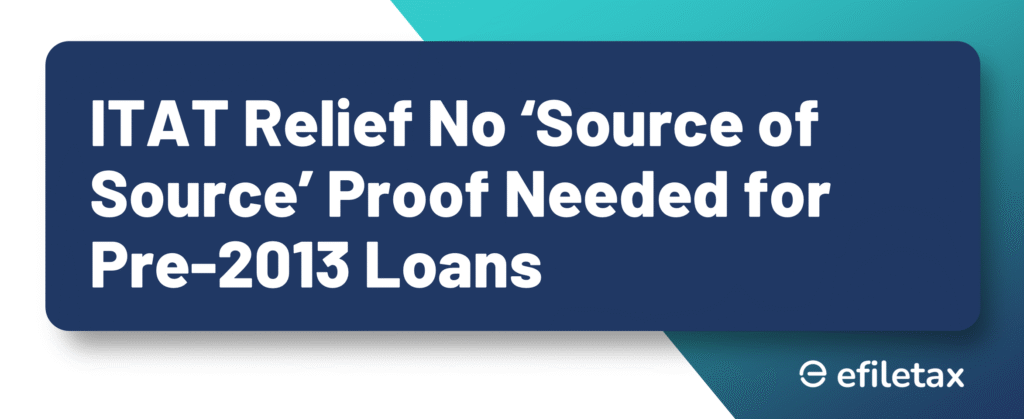
ITAT Quashes ₹1.26Cr Addition No Need to Prove ‘Source of Source’ for Pre-2013 Loans
In a major relief to taxpayers, the Income Tax Appellate Tribunal (ITAT) recently ruled that borrowers need not establish the source of source for genuine unsecured loans taken before June 1, 2013. The ruling came while deleting an addition of ₹1.26 crore made by the Assessing Officer (AO) under Section 68 of the Income-tax Act, 1961.
This judgment reaffirms the legal position that the stricter post-2013 amendment cannot be applied retrospectively.
What is ‘Source of Source’ in Income Tax?
- Under Section 68, if any sum is found credited in a taxpayer’s books, they must explain:
- The identity of the creditor
- The creditworthiness of the creditor
- The genuineness of the transaction
- After the Finance Act, 2012 (w.e.f. 01.04.2013), a proviso was added to Section 68 for closely held companies, requiring them to also explain the source of source — i.e., where the creditor got the money from.
ITAT Case Highlights
- Court: ITAT Delhi Bench
- Appeal No.: ITA No. 6793/Del/2018
- Assessee: Private limited company
- AY in Question: 2011–12
- Issue: AO made a ₹1.26 Cr addition citing unexplained cash credit under Section 68
- Observation: The loan was supported by PAN, confirmation, bank statement
- Ruling: AO cannot demand source of source for AYs before 2013
Why This Ruling Matters
No retrospective application:
The Tribunal reiterated that the requirement to prove source of source applies only after 01.04.2013 for share application money or loans in closely held companies.
Genuine loans are protected:
If an assessee has already proved identity, creditworthiness, and genuineness, the burden does not extend further — unless the law explicitly demands it.
Legal clarity for past assessments:
Taxpayers facing scrutiny for AYs before 2013 can rely on this ruling to defend legitimate transactions.
Expert View: Stick to Documentation
According to tax professionals, maintaining proper loan agreements, bank statements, PAN of lenders, and confirmations is key — even for old transactions. While source of source isn’t required before 2013, primary documentation must still be airtight to avoid additions under Section 68.
Section 68: Pre vs Post 2013 Comparison
| Criteria | Pre-2013 | Post-2013 (w.e.f. 01.04.2013) |
|---|---|---|
| Applicable to closely held cos | Yes | Yes |
| Need to prove source of source | No | Yes (Proviso to Sec 68) |
| Valid documentation needed | Identity, creditworthiness, genuineness | Plus, source of funds of creditor if company receives share application money |
Legal Basis
- Section 68, Income-tax Act, 1961
- Proviso inserted by Finance Act, 2012 effective from AY 2013–14
- Refer ITAT Delhi decision in XYZ Pvt Ltd v. ITO (ITA No. 6793/Del/2018)
📄 Official Bare Act Link:
Income Tax Act, 1961 – Section 68 (incometaxindia.gov.in)
Practical Tip for Taxpayers
If your assessment involves loans or share application money from before 01.04.2013, and you have proper paperwork proving the three key elements (identity, creditworthiness, genuineness), the AO cannot demand details of the lender’s funding source.
This ruling may be useful in filing appeals or arguing against re-assessment notices based on source of source grounds for older AYs.
Final Thoughts
The ITAT’s judgment reinforces a simple tax principle — the law cannot be stretched beyond what was applicable in a given year. For Indian businesses and individuals facing scrutiny over old unsecured loans, this is a welcome clarity.
🔗 Need help with tax notices or appeals?
Efiletax helps you respond to Section 68 additions and ITD queries →
SEO Snippet (40–50 words)
ITAT Delhi ruled that source of source need not be proved for loans taken before April 1, 2013, offering relief in a ₹1.26 Cr addition case under Section 68. Taxpayers must still show identity, creditworthiness, and genuineness of the creditor with proper documentation.
FAQ: Source of Source for Loans
Q1. What is ‘source of source’ in income tax?
It means proving where your creditor got the money from — beyond just showing their identity or creditworthiness.
Q2. When is ‘source of source’ required under Section 68?
Only from AY 2013–14 onwards for closely held companies receiving share capital, premium, or loans.
Q3. Can I use this ITAT ruling in my case?
If your assessment year is before 2013 and facts are similar, yes — it can strengthen your case.
Q4. What documents help prove genuineness of loan?
Loan agreement, PAN and address proof of lender, bank statement showing transaction, confirmation letter.